Birdfinding.info ⇒ Uncommon to rare over most of its large range. In the U.S., Sax-Zim Bog in Minnesota is probably the most consistent, readily accessible site. Yellowstone National Park and surrounding areas also support a sizeable population, as do the mountains of western Montana and adjacent Idaho. In Canada, the foothills west of Calgary (including Bluerock Wildland Provincial Park and Route 40) and Route 307 east of Winnipeg are fairly consistent, accessible areas. In Europe, it is found somewhat regularly around Helsinki and is seen consistently in northern Finland around Oulu. In Siberia, accessible areas with high densities include Yekaterinburg and Novosibirsk.
Great Gray Owl
Strix nebulosa
Taiga and montane coniferous forests of Eurasia and North America.

Approximate distribution of the Great Gray Owl. © Xeno-Canto 2022
Throughout its large range, it typically prefers landscapes that combine mixed coniferous and deciduous forests with meadows or bogs, and it often patrols the margins between wooded and open habitats.
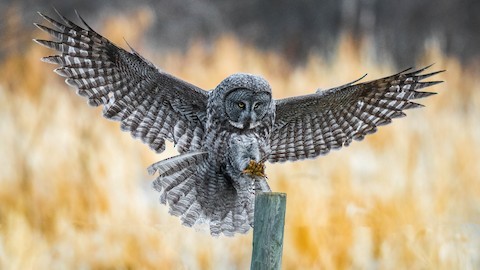
Great Gray Owl, S. n. nebulosa, alighting on a fencepost in northern Alberta. © Bob Bowhay
In Eurasia, it is resident across the taiga from northern and central Sweden, Finland, Belarus, and northern Ukraine east to the Anadyr Peninsula and Sakhalin. During the 2000s, it has extended its range southwest, with recent first-time breeding records in Estonia, Latvia, and eastern Poland.
In North America, resident from central Alaska east through forested regions of Canada to western Quebec, and south in several mountain ranges into the western U.S., including the Cascades, the Sierra Nevada, the Blue Mountains, and the Rockies (south to northern Utah).
Populations in some regions are notably nomadic, wandering in response to prey population collapses and bonanzas. This results in winter irruptions, sometimes small and sometimes large, into portions of western and southern Scandinavia and the Baltic states, and in North America south and east into the northern Great Lakes and the St. Lawrence River Valley.
Vagrants sometimes wander to the Pacific lowlands anywhere from British Columbia to northwestern California, the southern Great Lakes, the Maritime Provinces, southern New England, and Pennsylvania.
Identification
Distinctive: a very large, mostly gray owl with a prominent white “bow-tie” marking on the bottom of its well-defined facial disk.

Great Gray Owl, S. n. nebulosa, dorsal view with head rotated to look backward. (Big Bar Lake Provincial Park, British Columbia; June 2022.) © Braden Judson
One of the world’s largest owls by measurements, though its overall size is enhanced by a long tail and a large head, so it is less massive than other owl species of comparable length.
The head often appears almost spherical except for the flattened facial disk, which is roughly circular and strikingly patterned with concentric pale and dark rings in a radiating pattern around the eyes. In the center of the facial disk is a prominent pale-gray X between the eyes.
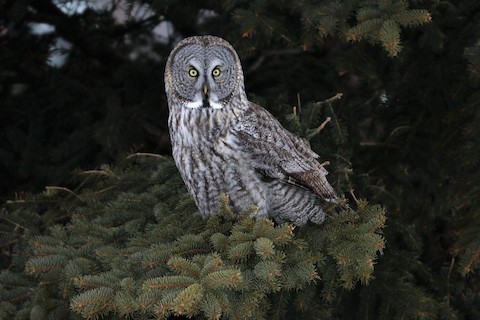
Great Gray Owl, S. n. nebulosa, ventral view, showing mixed pattern of streaks and bars on the underparts. (St. Louis County, Minnesota.) © Alex Sundval
The eyes are bright-yellow and the bill is yellowish. Its eye color distinguishes it from all other Strix owls that occur in or near its range.
The plumage has a vermiculated pattern comprised of various shades of gray, sometimes much browner on the upperparts.
Eurasian and American populations differ most noticeably in the pattern on the underparts. Eurasian birds typically show bold longitudinal streaks, whereas American birds typically have a subtler pattern of mixed barring and streaking.

Great Gray Owl, S. n. lapponica, side view showing enormous head size and slightly concave facial disks—also note bold streaks on the underparts, typical of lapponica. (Helsinki, Finland; March 1, 2013.) © Pekka Malinen

Great Gray Owl, S. n. lapponica, ventral view in flight, showing dark terminal band on the tail. (Northern Ostrobothnia, Finland.) © Matti Rekilä
Eurasian birds typically show a distinct dark-gray terminal tail-band, whereas American birds usually show only a subtle tail-band, if any.
Notes
Polytypic species consisting of two recognized subspecies: nebulosa of North America, and lapponica of Eurasia.
More Images of the Great Gray Owl

Great Gray Owl, S. n. nebulosa. (Bluerock Wildland Provincial Park, Alberta; December 2018.) © M. Randall
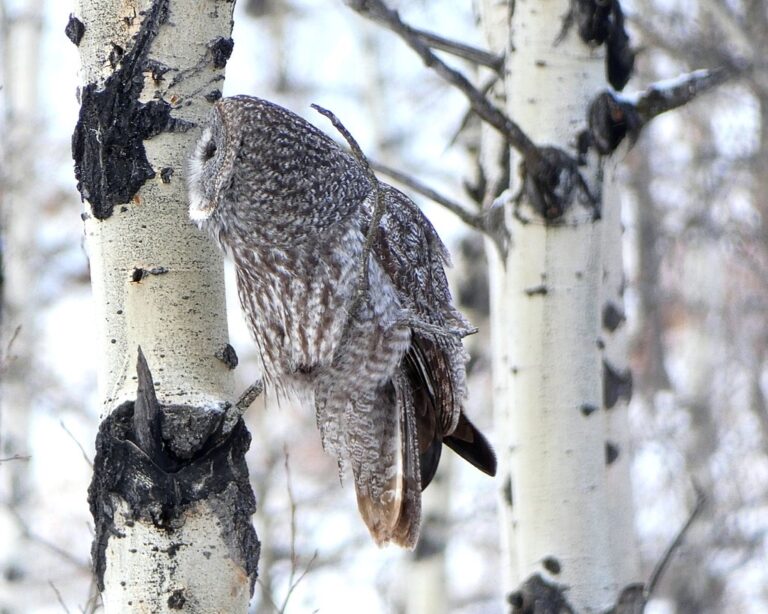
Great Gray Owl, S. n. nebulosa. (Bluerock Wildland Provincial Park, Alberta; December 2018.) © M. Randall

Great Gray Owl, S. n. nebulosa. (Athabasca, Alberta.) © Gerald Romanchuk
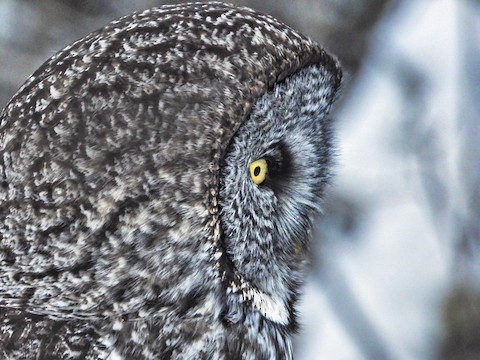
Great Gray Owl, S. n. nebulosa. (St. Louis County, Minnesota.) © Simon Tolzmann

Great Gray Owl, S. n. nebulosa. (Idaho Falls, Idaho; March 2022.) © Cameron Ricks

Great Gray Owl, S. n. nebulosa. (St. Louis County, Minnesota.) © Steve Kolbe
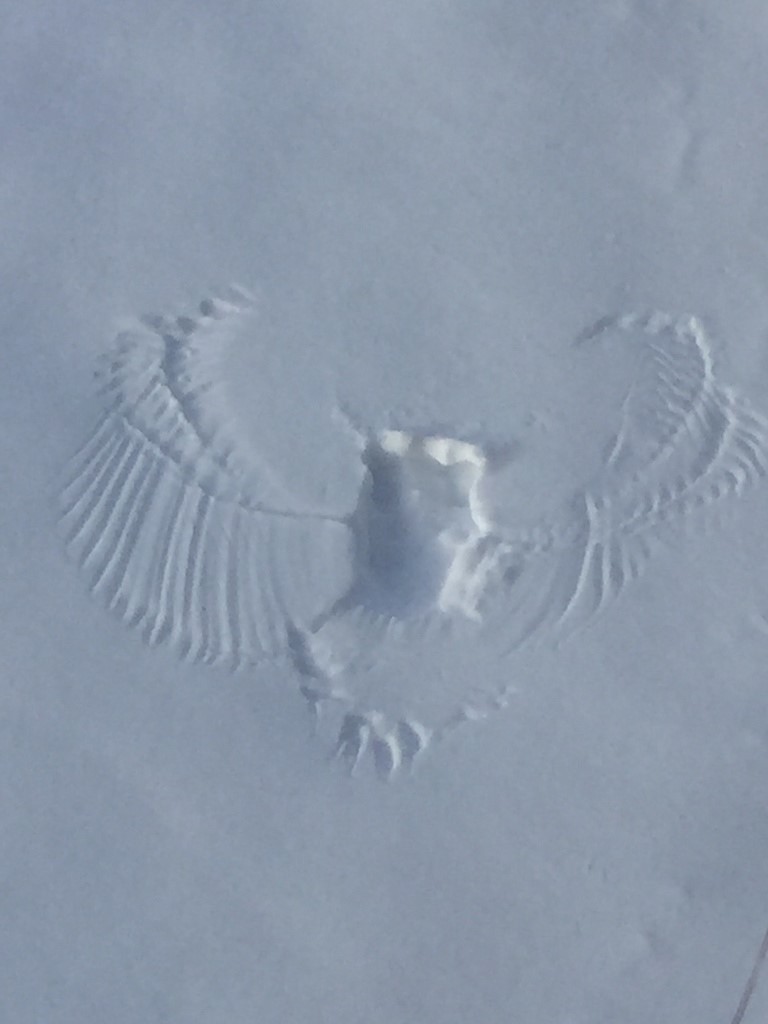
Great Gray Owl impression in snow after prey capture attempt. (Calgary, Alberta; January 2021.) © karints
References
Alderfer, J., and J.L. Dunn. 2019. National Geographic Complete Birds of North America (Third Edition). National Geographic Society, Washington, D.C.
BirdLife International. 2021. Strix nebulosa. The IUCN Red List of Threatened Species 2021: e.T22689118A199144259. https://dx.doi.org/10.2305/IUCN.UK.2021-3.RLTS.T22689118A199144259.en. (Accessed December 25, 2022.)
Brazil, M. 2009. Birds of East Asia. Princeton University Press.
eBird. 2022. eBird: An online database of bird distribution and abundance. Cornell Lab of Ornithology, Ithaca, N.Y. http://www.ebird.org. (Accessed December 25, 2022.)
König, C., and F. Weick. 2008. Owls of the World (Second Edition). Yale University Press.
Mikkola, H. 2012. Owls of the World: A Photographic Guide. Firefly Books, London.
Mullarney, K., L. Svensson, D. Zetterström, and P.J. Grant. 1999. Birds of Europe. Princeton University Press.
Salt, W.R., and J.R. Salt. 1976. The Birds of Alberta. Hurtig Publishers, Edmonton, Alberta.
Xeno-Canto. 2022. Great Grey Owl – Strix nebulosa. https://xeno-canto.org/species/Strix-nebulosa. (Accessed December 25, 2022.)
